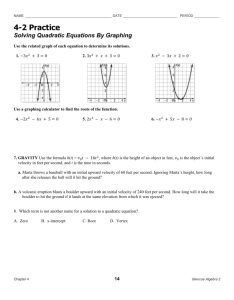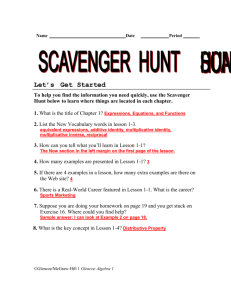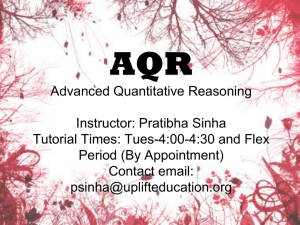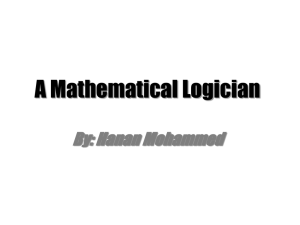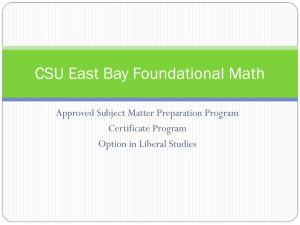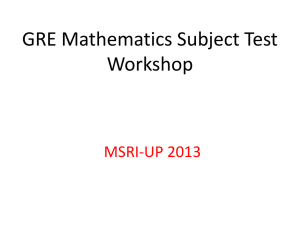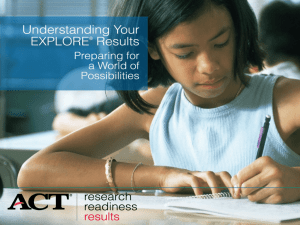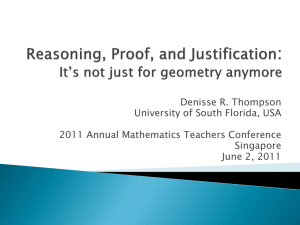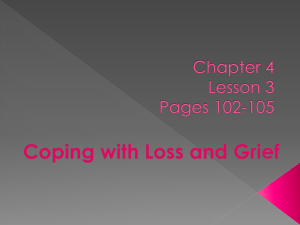Huntley_PPT
advertisement
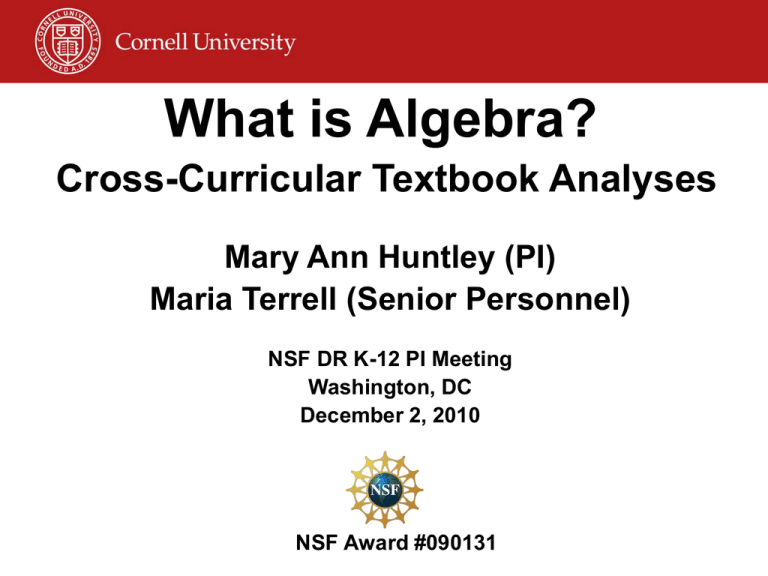
What is Algebra? Cross-Curricular Textbook Analyses Mary Ann Huntley (PI) Maria Terrell (Senior Personnel) NSF DR K-12 PI Meeting Washington, DC December 2, 2010 NSF Award #090131 Project Advisors/Consultants Hyman Bass (University of Michigan) Herb Clemens (Ohio State University) Jim Hiebert (University of Delaware) Sarah Theule Lubienski (University of Illinois Urbana-Champagne) Wei Pan (University of Cincinnati) Maria Araceli Ruiz-Primo (University of Colorado Denver) Norman Webb (University of Wisconsin Madison) What is Algebra? Hyman Bass (November 20, 2008) Rationale There is large variation in the content of courses called “algebra” in the US and abroad (Kendal & Stacey, 2004). Characterizing textbooks as either “traditional” or “reform” masks important distinctions between programs that really are quite different (Huntley, 2008). Describing these differences in coherent, comprehensive, and commensurable ways will allow curriculum decision makers and other stakeholders to compare curricula and make informed decisions. Textbooks Analyzed Subject Specific Integrated* Core-Plus Mathematics Program (CPMP), Glencoe/McGraw-Hill (2008-2009) Commercially Generated Glencoe Algebra 1 & 2 (2008) Extensive Field Testing during Development University of Chicago School Mathematics Project (UCSMP), Wright Group (2008/2009) Interactive Mathematics Program (IMP), Key Curriculum Press (20082009) *Only units in Years 1-3 with major focus on algebra (as identified by the textbook authors). Research Question What are the characteristics of different curricular approaches to high-school algebra? – What is the content, including the breadth, sequence, and depth of topics covered? – What sets of behaviors are expected of students as they engage with the content? Analytical Frameworks Content Survey of Enacted Curriculum (SEC) K-12 Mathematics Taxonomy (Wisconsin Center for Education Research, 2007) Cognitive Behavior TIMSS Advanced 2008 Assessment Framework (Garden et al., 2006) Coding Procedures Every textbook item is coded by two people – Narrative (excluding worked-out examples) – Exercises (homework problems) Coders –Mathematician (Terrell) –Mathematics Educator (Huntley) – 2 High-School Teachers (10+ years of experience, master’s degree) Periodic Reliability Checks Status of Coding Subject Specific Integrated* Core-Plus Mathematics Program (CPMP), Glencoe/McGraw-Hill (2008-2009) (n = 7,537) Commercially Generated Glencoe Algebra 1 & 2 (2008) (n = 17,012) Extensive Field Testing during Development University of Chicago School Mathematics Project (UCSMP), Wright Group (2008/2009) (n = 13,677) Interactive Mathematics Program (IMP), Key Curriculum Press (20082009) * Only units in Years 1-3 with major focus on algebra (as identified by the textbook authors). Preliminary Results Distribution of Content Pie charts show the percentage of items in each content area, arranged clockwise starting from the tick mark. Preliminary Results Frequency of Content 10 most frequently used content codes in each curricular program CPMP % Glencoe % UCSMP % 1 1503 – Linear Functions 13.0 1 510 – Rate of Change/Slope/Line 6.9 1 510 – Rate of Change/Slope/Line 10.8 2 1504 – Quadratic Functions 9.3 2 601 – Quadratic Equations 6.3 2 511 – Operations on Polynomials 8.1 3 1508 – Exponential Functions 7.6 3 507 – Multi-Step Equations 5.1 3 1504 – Quadratic Functions 8.0 4 605 – Matrices & Determinants 6.6 4 511 – Operations on Polynomials 4.7 4 507 – Multi-Step Equations 6.3 5 1406 – Iteration & Recursion 6.5 5 515 – Rational Expressions & Eqns 4.6 5 508 – Inequalities 5.3 6 511 – Operations on Polynomials 5.9 6 508 – Inequalities 4.5 6 512 – Factoring 4.8 7 601 – Quadratic Equations 5.5 7 602 – Systems of Linear Eqns 4.5 7 502 – Use of Variables 4.7 8 510 – Rate of Change/Slope/Line 4.3 8 512 – Factoring 4.5 8 602 – Systems of Linear Eqns 4.4 9 602 – Systems of Linear Eqns 3.8 9 1504 – Quadratic Functions 4.2 9 601 – Quadratic Equations 4.4 10 1515 – Power Functions 3.4 10 503 – Eval of Formulas/Exprs/Eqns 4.2 10 306 – Area & Volume 3.8 Preliminary Results Content vs. Time Plots of topic codes as a function of "time" (which is represented as the unit/chapter in the textbook) reveal differences in density, distribution, and sequencing of content topics. Glencoe Algebra 1 Topic vs. Chapter Glencoe Algebra 2 Topic vs. Chapter Preliminary Results Cognitive Behaviors Pie charts indicate differences in the percentage of items in each curriculum for each cognitive dimension. Preliminary Results In addition to coding for content and cognitive behavior, other easilyobtainable information is gathered during the coding process – Use of tools (calculators, computers, manipulatives) – Use of real-world contexts 50 45 40 35 CPMP UCSMP GLENCOE 30 25 20 15 10 5 0 Real-World Context Calculator/Computer Manipulatives Next Steps Use highly-specialized software, originally developed for ecologists, for analyzing massively multivariate data with very sparse matrices. (Richard Furnas, Cornell University biometrician) Conclusion There is tremendous variation in the algebra content of commercially available high-school textbooks, which translate into quite different opportunities for students to learn algebra. This analysis does not tell us how these differences differentially impact student learning.
